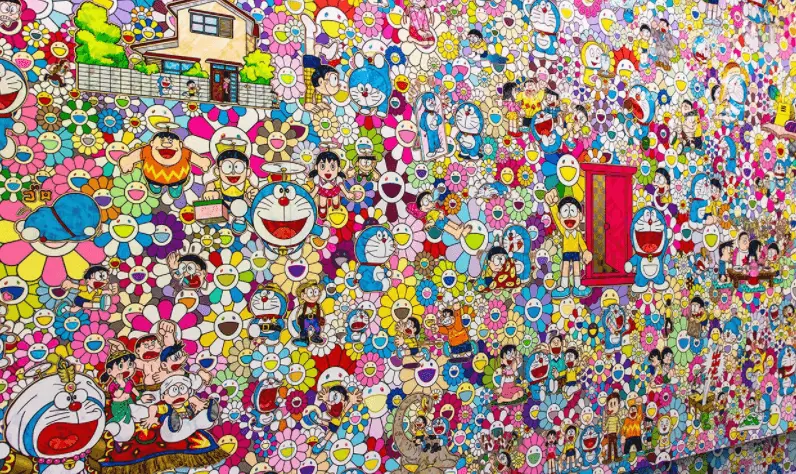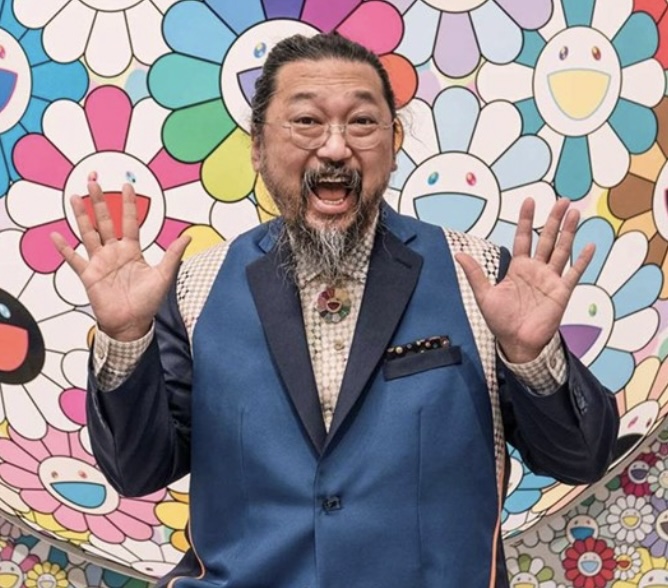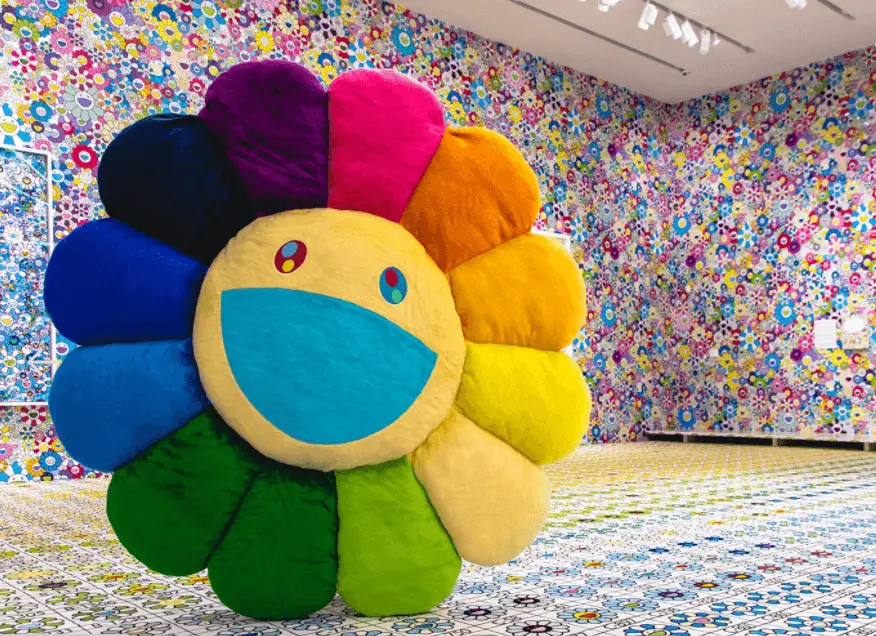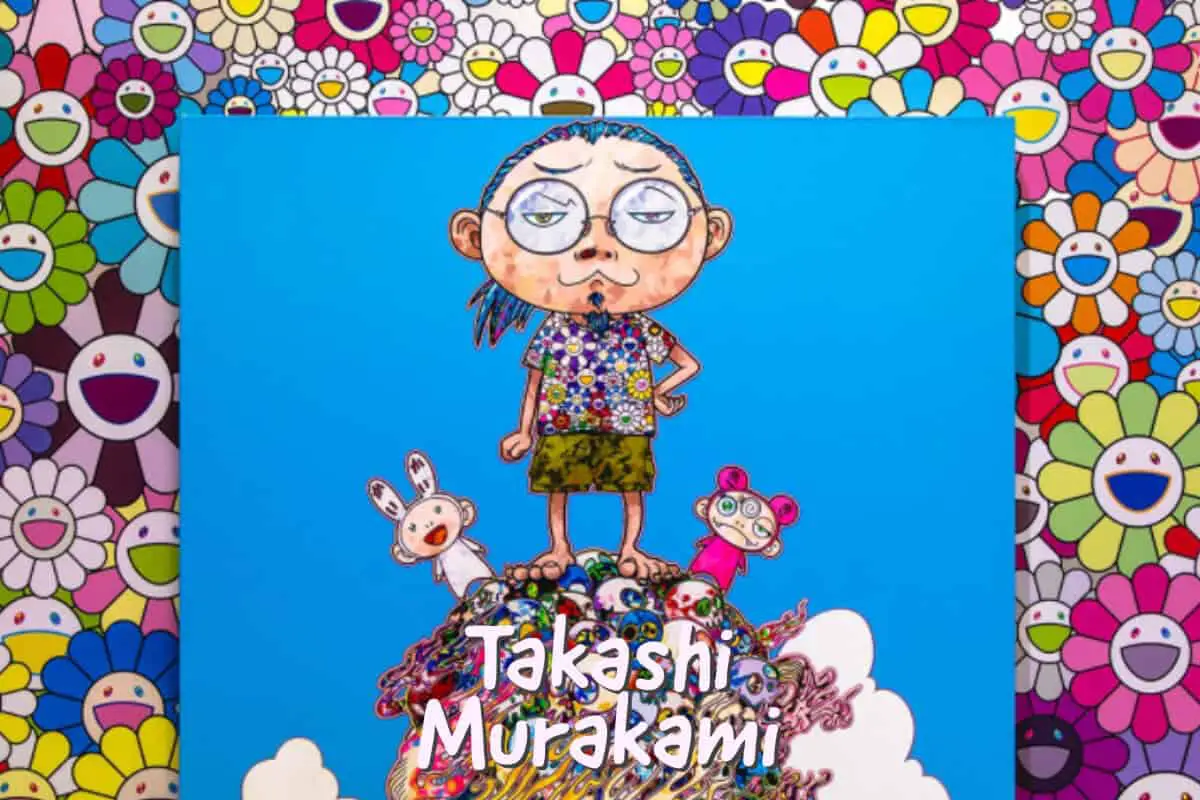Takashi Murakami is one of the most successful and well-known Japanese artists. His art teacher once called him “talentless” and said he had no ability to put any colors together. Today Takashi Murakami is considered an artistic trailblazer blazer.
Takashi Murakami’s art successfully blurs the art lines between high and low culture. Takashi has successfully collaborated and used his art on products produced by many major brands. Today you can see the Murakami flowers on fine art, pop culture, fashion, to commercial products.
Table of Contents
- The Popularity of The Iconic Artist Takashi
- Superflat Art Movement
- Frequently Asked Questions About Takashi Murakami
- Related Content

The Popularity of The Iconic Artist Takashi
Takashi Murakami is a contemporary Japanese artist known for blurring the lines between high art and commercial art. He is an artistic trailblazer that has changed the artwork.
In 2002 he changed the way we view the iconic brand Louis Vuitton. Takashi collaborated with Louis Vuitton to design a series of handbags using its monograms in ways it has never been used before. It was a huge success and helped Takashi become a commercial success.

His relationship with Louis Vuitton and Marc Jacobs lasted for 13 years. That is, by all accounts a long time for an artist to collaborate with a brand.
Some art critics felt that he was using his art with too much commercialization; it took away from the art. For example, during a Takashi Murakamiart exhibition at the Museum of Contemporary Art in Los Angeles, there was also a pop-up store selling Louis Vuitton handbags.
Paul Schimmel, the Museum of Contemporary Art, Chief Curator, told the New York Times how Takashi Murakami understood commercialization and art.
“One of the most radical aspects of Murakami’s work is his willingness both to embrace and exploit the idea of his brand, to mingle his identity with a corporate identity and play with that. He realized from the beginning that if you don’t address the commercial aspect of the work, it’s somehow like the elephant in the room.”
In 2007 Takashi Murakami provided the cover artwork for the rapper Kanye West’s album “Graduation.” He also directed an animation video for “Good Morning” and a music video for Billie Eilish for his song “You Should See Me in a Crown.”
You can watch the official video of Billie Eilish, You Can See Me In The Crown, below.
In 2010 the Palace of Versailles in France had a Takashi Murakami Art Exhibition within the palace. Many of these pieces also included his Murakami flowers.
He has also teamed up with the French water brand Perrier to add decoration to their bottles. The bottles have his icon flowers and art style on them.
This has helped Takashi become an international star, especially in China and the United States. This, plus his well-known commercial projects, has helped him rise to artistic stardom and popularity.
Below is a really great interview by Carlos Watson from the Carlos Watson Show when he interviewed Takashi.
The Murakami Flower
One of Takashi Murakami’s most iconic images is Murakami Flower. The first time Murakami flowers were shown was in 1995. You can see these Murakami Flowers on everything from jewelry, watches, shoes, skateboards, clothing, and bags.
The Murakami Flower has its roots in me traditional Japanese painting. The flower has always been an important symbol in Japanese traditional painting.

Takashi Murakami’s flower artwork sells for millions of dollars. But it has also taken over pop culture, and the Murakami Flowers can be found on all objects. The Murakami Flower is found on everything from food packaging to pop culture to luxury goods; the Murakami Flower has transcended all kinds of art.
But these Murakami Flower drawings are not just simply flowers. When you look at his Murakami Flowers you can see that the flowers have some hidden tears.
Takashi Murakami and the Murakami Flowers have bridged the gap between consumerism, fine Art, fashion, pop culture, and streetwear; these art forms have been touched with Murakami Flowers.
Takashi Murakami shows us all that fine artists can also be successful commercial artists and that fine artists can collaborate with well-known and iconic brands.
The discover more about these Murakami Flowers, below is a “Behind the Hype” Video called “The Hysteria of This Flower Explained – Murakami Flowers.”
Superflat Art Movement
It is tough to talk about Takashi Murakami without talking about the word he coined called “Superflat.” Superflat is a post-modern art music movement founded by Takashi Murakami.
Superflat is used to refer to various flatforms in Japanese graphic arts. The movement is influenced by two Japanese movements, Magna and Anime, which are:
- Manga – Manga is Japanese art from comics and graphic novels; art refers to comics and cartooning. Most Manga arts conformed to Japan’s style in the late 19th century; the art form originated from early Japanese art.
- Anime – Anime is a hand-drawn or computer animation art form that originated in Japan. Anime describes all animated works regardless of style or origin. Outside of Japan and in English, any animation influenced by the Japanese style is called anime-influenced animation. The earliest commercial Japanese animation goes back to 1917.
Takashi Murakami’s Superflat art movement includes various Japanese graphic arts, animation, pop culture, and fine arts. The major artists considered Superflat are Takashi Murakami, Chiho Aoshima, Mahomi Kunikata, Sayuri Mishima, Yoshitomo, and Aya Takano.
American artists have also embraced Superflat with a hybrid version called SoFlo Superflat. The American SoFlo Superflat started in Miami in the 1990s and was an urban pop art movement in South Florida that combines super bright colors and ultra-flat images.
The subject matters could be quite diverse, but SoFlo Superflat was the outcrop of the Japanese Superflat art movement. The artists who work is considered SoFlo Superflat is Britto, Caron Bowman, Raul Cremata, Ceron, Ed King, and Jose Alvares.
Takashi Murakami Is a great example of how artists can use their work as fine and commercial art. He truly is a trailblazer that has paved the way for other artists to follow him.
Anita Louise Art is dedicated to art education, great artists, and inspiring others to find and create their art. We love art that uplifts and inspires. #ArtToMakeYouSmile! #ArtToMakeYouHappy!
If you want to see any of my art, you can find out more by clicking here. If you are interested in what inspires me and my paintings, you can discover more by clicking here.
We have a free newsletter and would love you to be part of our community; you can subscribe to the newsletter by clicking here. If you have any questions, I would be happy to talk to you anytime. You can reach me, Anita, by clicking here.
Subscribe to our Anita Louise Art YouTube Channel with great videos and information by clicking here.
Join us for our podcast “5 Minutes With Art.” Spend 5 minutes a week with us to discover and learn about great art and artists. You can find out more about our podcast by clicking here.
Frequently Asked Questions About Takashi Murakami
Who is Takashi Murakami?
Takashi Murakami is a contemporary Japanese artist known for his pop art and super flat style.
What is the super flat style?
Superflat is a postmodern art movement characterized by its use of flat, bright colors and two-dimensional imagery.
What are some of Takashi Murakami’s most famous works?
Some of Murakami’s most famous works include “Flowerball,” “My Lonesome Cowboy,” and “Miss Ko2.”
What is the meaning behind Murakami’s “Flowerball” artwork?
“Flowerball” is a representation of the Buddhist concept of “enlightenment” or “nirvana.” Murakami uses the flower motif to express his belief in the beauty and fragility of life
What is the meaning behind Murakami’s “My Lonesome Cowboy” artwork?
“My Lonesome Cowboy” is a representation of the artist’s struggles with loneliness and the quest for self-discovery.
What is the meaning behind Murakami’s “Miss Ko2” artwork?
“Miss Ko2” represents the artist’s fascination with the anime and manga culture in Japan. The artwork features a woman with exaggerated features, a common theme in Japanese anime.
What is the meaning behind Murakami’s “And Then…” artwork?
“And Then…” represents the artist’s belief in the cyclical nature of life and death. The artwork features a skull with cartoon-like features, symbolizing the juxtaposition of life and death.
What is the significance of Murakami’s use of the term “otaku” in his artwork?
“Otaku” is a Japanese term that refers to people obsessed with anime, manga, and other forms of pop culture. Murakami uses the term in his artwork to comment on the role of pop culture in contemporary society.
Related Content
What Type Of Artist Is Andy Warhol?
Andy Warhol is a Pop Artist; he is one of the Pop Art Movement’s major figures. Andy Warhol’s artwork explored the relationship between what is known as the mass popular cultures of his day and art. He used many iconic American objects in his art and also painted many celebrities.
You can discover more by reading What Type Of Artist Is Andy Warhol? by clicking here.
What Is Pop Art In Simple Terms?
Pop Art use imagery from advertising, comic books, and other mass-produced cultural objects. Pop Art was seen as a reaction to the Abstract Expressionism art movement. Pop Artists would purposefully use familiar mass culture images. Many times Pop Artists made artistic statements about world events in their Pop Art. The main years for the Pop Art movement were the 1960s and 1970s.
You can learn more by reading What Is Pop Art In Simple Terms? by clicking here.


